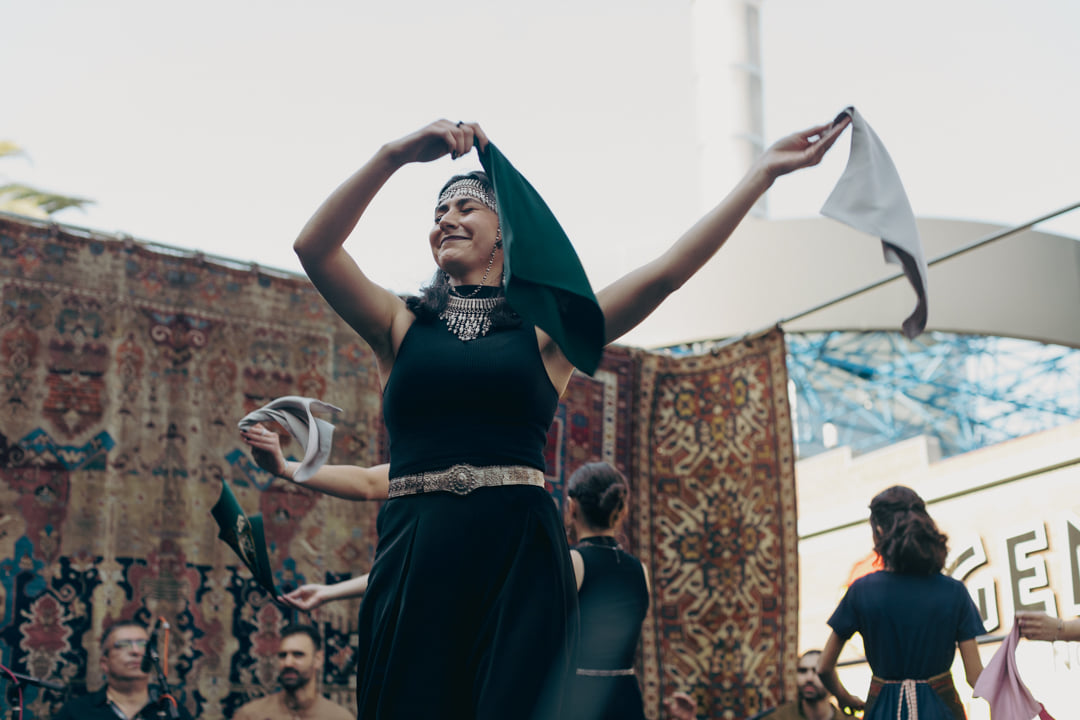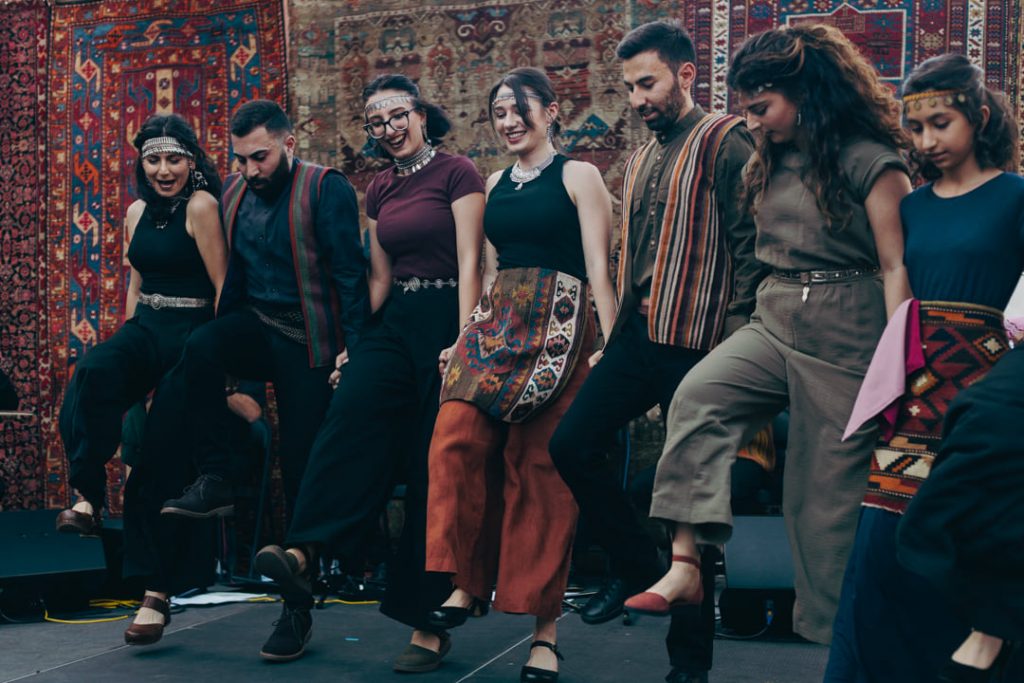
This article is part of Azad Sparks: Critical Conversations for the Armenian Community. Azad Sparks is an interview series dedicated to starting transnational conversations on the topics that aren’t often talked about in prevailing Armenian discourse. Here we ask the difficult questions, break the silence on marginalized topics, and build alternative communities.
Natalie Kamajian is a PhD student in Culture and Performance at UCLA. Her work examines the dominant staged expressions of Armenian dance in contrast to vernacular dances, and how Armenian identity is constructed and expressed through dance. Thinking about the complex and fraught conversations that often occur around Armenian identity, I sat down with Natalie to learn more about her work.
Azad Archives: To start off, can you talk about your research and how you became interested in Armenian vernacular dance?
Natalie Kamajian: My research on Armenian dance sits between both dance studies and Armenian studies and is not prominent in either body of scholarship. On one hand, I’m trying to insert Armenian dance topics and scholarship into the dance studies field, and on the other hand, I’m encouraging Armenian studies to consider dance as a valuable modality for unpacking Armenian history and learning about how Armenian identity is constructed.
In terms of my interest, I’ve always been dancing. As a kid I practiced and performed tap dance for twelve years, but I was never introduced to Armenian traditional or vernacular dances until I came to Armenia in 2012. I lived here for a year when I was fresh out of undergrad and I started taking dance classes. That was when the outdoor dance gatherings at Cascade had just started, so it was really a transformative experience for me in terms of how one can express their Armenianness through dance.
It has a strong political framing for me too. What we see at the Yerevan Opera House or at dance studios in LA has a different history and movement vocabulary than these vernacular dances. In my scholarship now, I’m writing about how there are actually different genres of Armenian dance, a perspective that complicates what we often just label as “Armenian dance.” This is not unique to Armenians—we see the use of “Indian dance,” “African dance” as well, but what do those unitary labels really mean when there is so much diversity within Indian, African, and Armenian dance practices?
I also look specifically at how Armenians danced in Western Armenia. A lot of that is taken from archival footage, ethnographic documents, interviews, and even knowledge passed on through bodily memory. It creates this whole alternative to what we see on stage, the dominant performance genre that I refer to in my thesis as bemakan par or “staged dance.”
In addition to that, I lead a performance ensemble called Lernazang. So I try to approach this work from all angles—academic, performing arts, and community-based work—which is primarily focused on getting folks connected to and acquainted with our rich vernacular dance heritage in diaspora.
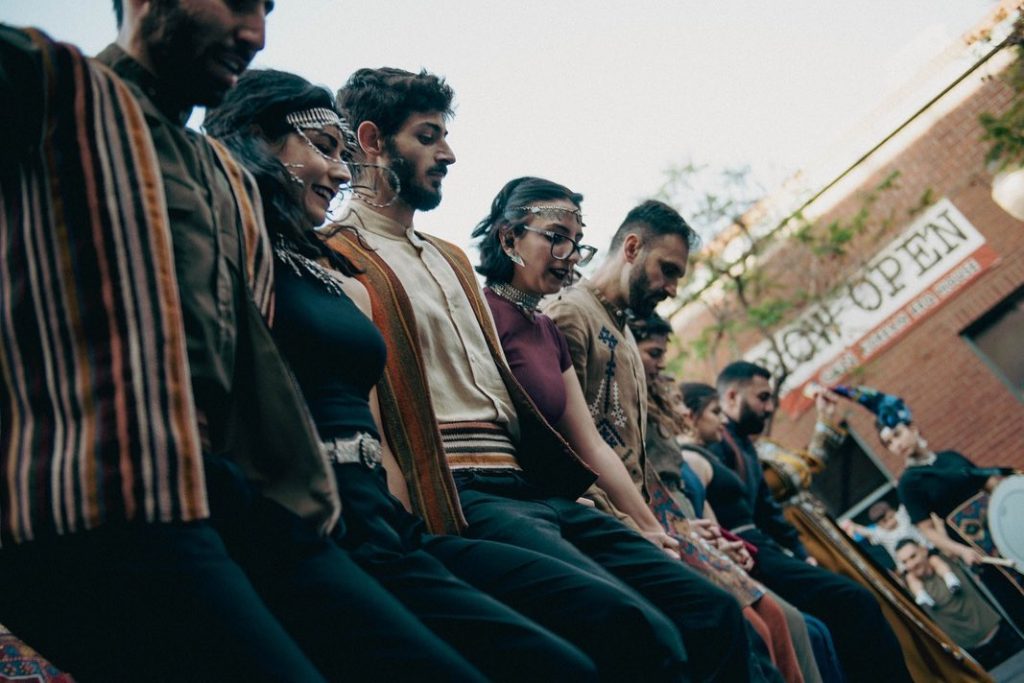
AA: I love that you do both theory and practice. How has your work with Lernazang influenced your academic work and vice versa?
NK: I wouldn’t be able to write about this form if I didn’t practice it. In the field of dance studies it’s highly encouraged that you, at least to some degree, practice or participate or are in some sort of proximity to the dance form you are researching and writing about. For my academic work, the combination of dancing, writing, and also teaching helps me to put my words together and articulate what’s going on both in the form and from a sociological/community-based perspective as well. More importantly, politics is not separated from the arts for me, so my academic work asserts my own practice and teaching as a very political act.
AA: How does politics come into your work?
NK: I believe that learning and studying vernacular dances is a decolonial practice. There are a lot of levels and layers to it for me. I was born in Los Angeles so I consider myself a diasporan Armenian, and my Armenianness is always in competition with having to survive both in an economic and a cultural sense under capitalism in the United States.
Also, bemakan par is the most predominant form of Armenian dance, the form that is considered by most Armenians to be the most “traditional” and “pure”—however it is a form that is primarily influenced by ballet aesthetics and technique. Ballet is the basis of bemakan par; the rules and style of ballet dictate how the bodies move, and how people think and talk about dance and themselves too. By that I mean, how you dance articulates what you believe, and this creates a whole framework for how you see the world. Most of the bemakan par dancers and instructors that I have spoken with say that vernacular Armenian dances are primitive, boring, and uninteresting because they’re “underdeveloped.” For them, ballet is THE way to express themselves in a dance context; Armenianness is “improved” and “civilized” through an encounter with ballet. What does that do for the psyche and for our community when we look at our dances as being not good enough? As being “uncivilized?” This to me is an internalized colonial mentality. And I think it’s a pattern that we can identify with regard to how Armenians think and feel about other elements of Armenian culture and heritage… not just dance.
AA: This strikes me as something I often see among Armenians—trying to prove the worthiness of our culture for a Western gaze. Do you see that in your work?
NK: Totally. There’s this global idea that ballet is the foundation of all dance. In any dance institution around the world there’s going to be ballet, which should tell us something—that there is prestige in knowing, learning, and dancing ballet and in mastering balletic style and aesthetics. If we take it one step deeper, there is also a prevailing idea that unless you practice ballet you don’t have a good stance or posture. But when we look at vernacular Armenian dances, oftentimes dancers are in a hunched over position. Our dances are close to the earth, and we are usually holding each other via hands, arms or by the waist—and that carries social and cultural significance. But when you adhere to the rules and values of ballet technique, which demands uprightness and lifted arms, the entire structure of the dance form changes completely. Bemakan par asks dancers to lift themselves up from the earth and detach from the people they are dancing with… that demonstrates that a prioritization has been made, to push what is understood as “Armenian dance” to be in fact more balletic and European than Armenian. Vernacular Armenian dance has a technique, it has a style—and it deserves to be practiced and taught on its own terms. That’s basically what I’m unpacking in my research and in my teaching and performance practice—the specific choreographic choices that are being made in the different Armenian dance genres demonstrates a value structure and it not only reveals how Armenians self-identity, but also reflects our collective history.
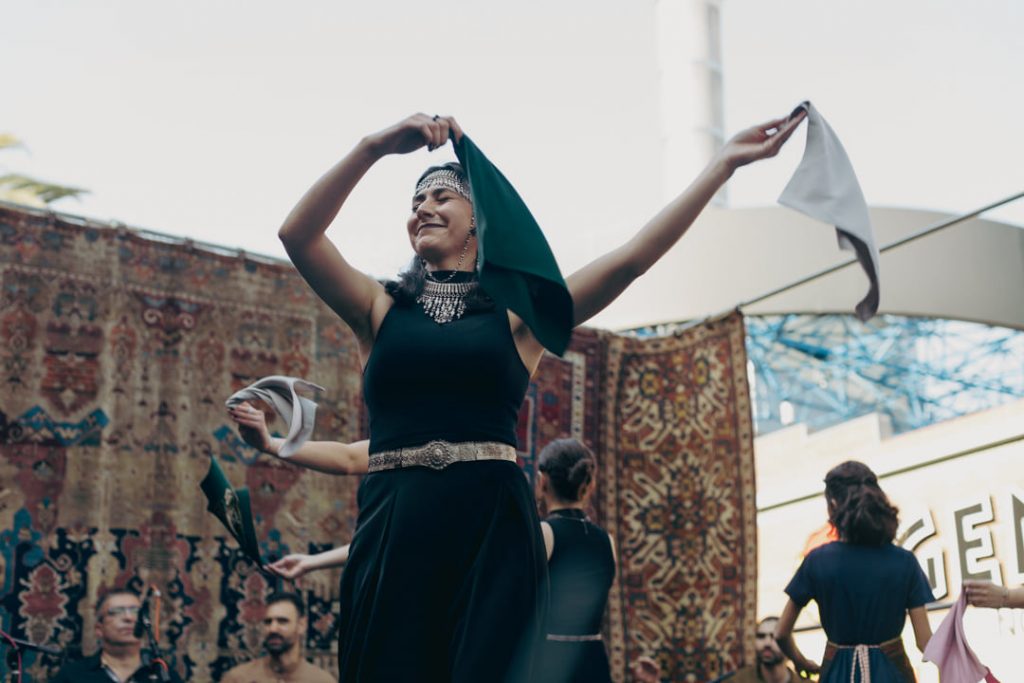
AA: I think unpacking these colonial mentalities is so important. What do you see as some of the historical roots of this very balletic form of dance?
NK: A long legacy of Soviet power and influence in Armenia and on Armenians globally plays a major role in the emergence of bemakan par and its current practice and performance. During the reign of Peter the Great, European ballet was domesticated and Russified. The Soviets integrated balletic movements and aesthetics into depictions of various folk dances for the stage—this became a kind of character dance, the root of which you can see in Russian ballets like the Nutcracker such as in the “Coffee” dance or “Tea” dance which are racist caricatures of “Arab” and “Chinese” cultures. Ultimately every Socialist Republic had a state dance ensemble, ballet school, and opera house and they basically created this form to transform ballet from something that was elitist to something that was accessible.
All of the instructors in these styles were trained in ballet first and foremost. As scholars within dance studies, we understand that your training in a particular form stays with you, it stays in your body. For instance, ballet dancers who have been training in the form since they were young tend to walk with turned out feet, because their muscles have adapted so much to that technique.
So if you’re trained in ballet, and you have a worldview that looks down on other forms as being underdeveloped and uncivilized because they’re not balletic, and then you also have this view of ballet as being the perfect training system for all bodies, if you go to a village and you see vernacular dances, let’s say, or you have a great uncle who knows a dance from Mush, you’ll both learn and then teach that dance in an already balleticized way.
Our dances are cyclical and circular, and they often have repeating phrases, because they were never meant to be performed on a stage, they were more just a part of life, something that people participated in, usually for ritual purposes. But then you have this phenomenon of a stage that separates performers from audience members. And you have people paying money to watch you, so you feel obligated to change things up, you add acrobatics and intricate formations, and you throw in a few soloists who perform big leaps and jumps. These are all things that came from Moscow, but you had Armenians championing the form and later exporting it to diaspora communities, which ultimately became a new, constructed genre of Armenian dance.
AA: What are some insights you’ve gained on Armenian identity from your work?
NK: Armenians have a lot of anxiety about their identity, That much is for sure. I think a lot of it is due to our very traumatic history—people who have experienced genocide or are descendants of those who have experienced it have every reason to have a complicated relationship with identity and the slew of other issues we see in our community.
One thing that I’m interested in complicating is this belief that somehow Armenianness is not a regional identity. Meaning, I think Armenians often try to carve out an idea of Armenianness that is exceptionally unique and that exists in a vacuum, unimpacted by any of our centuries-old neighbors. But Armenianness has been a fluid identity for so long, and it continues to be one. To bring it back to dance, I think it’s important to recognize that our indigenous dances are more similar to Assyrian and Kuridsh dances than they are to European dance styles that originated in the Italian and French courts. But there’s, unfortunately, this push to whitewash and Europeanize Armenianness—which I find problematic.
I see this playing out in geopolitics too. Armenians have a common enemy with Kurds, Assyrians, Palestinians, and many other groups—but where is our revolutionary spirit? When I read about our history, it’s there, but where has it gone? There’s a lot of wanting to assimilate and accommodate Western capitalist enterprise and these global systems that don’t care about us at the end of the day. This became really clear during the second Artsakh war. As a small nation, it makes sense, given our economic constraints. A small nation doesn’t have a lot of resources, doesn’t have a lot of money, doesn’t have things that anyone would want—we don’t have oil reserves to offer anyone. So I understand it, but at the same time, I wonder: how do we break that cycle?
AA: I feel like talking about it might be the first step to getting there.
NK: I would also say that there should be different expectations for Armenians living in Armenia and Armenians in the diaspora. Armenians in the diaspora have a greater privilege, a greater ability and responsibility to have a different, more critical ideological approach, whereas Armenians in Armenia are often focused on surviving. This dynamic is also not talked about enough.
AA: You’ve been working back and forth between Armenia and the U.S., right?
NK: Yeah, since 2012 I’ve come back almost every year for a few months at a time. I usually do a lot of my research in the summer.
AA: What has the experience been like doing work in the diaspora and in Armenia?
NK: I feel like I’ve created a community here in Yerevan that I know and trust and turn to and learn from all the time. I feel like a conduit sometimes, where I’m gaining access to so much rich knowledge here and doing my best to share it not only in academic settings but also in local LA Armenian spaces. The goal is really to uplift that knowledge and to demonstrate its value, not only for Armenians but for non-Armenians too.
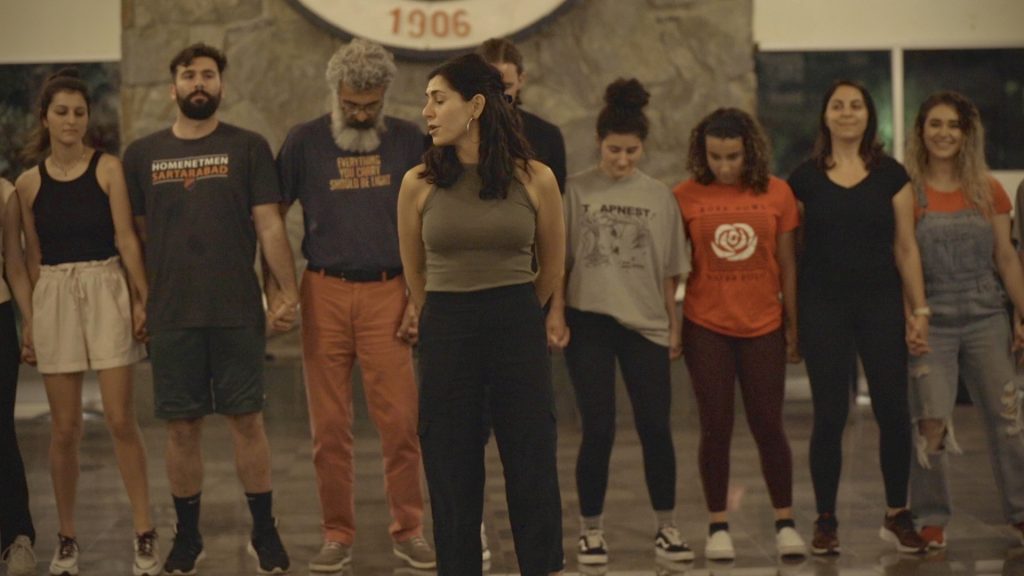
AA: Definitely. This is a departure from the dance conversation, but I remember that you did mutual aid work during the war. What was that like and how did you start it?
NK: In October of 2020 when the war had just started, my husband and I decided that we had to be in Armenia. It was really, really difficult to take in all the news while we were so far away, so it was an important decision for us to come and just be in Armenia. Actually, it really is connected to dance now that you say that because before the war we would come every year and have a good time conducting our research, dancing, learning from, and speaking with practitioners and other community elders. We source a lot of the content of our research from the local community here, so for us it felt really important to give what we could during a time of crisis. When so many of our youth agreed to sacrifice their lives to protect us, the least we could do was sacrifice our time, our work, and our safety so that we could be present and in community with a place and people we cherish deeply. If our homeland is in crisis, then we’re in crisis. We didn’t want to have a relationship with Armenia/ns that extracts all this knowledge and then leaves when things get rough.
It all happened so quickly—this Facebook post here, that one there, connect with these people here, and one ride to the airport with strangers in their huge pickup truck later, we were flying to Yerevan with around seven suitcases full of medical supplies and camera equipment for doctors and journalists on the frontlines.
After we were in Armenia for a month, in November, we had the idea of raising funds ourselves as a mutual aid effort where we could hand cash directly to the growing population of Artsakh refugees who were coming to Yerevan. When I posted it on Instagram, I was expecting a couple thousand dollars max, but we ended up raising around $28,000. When we saw that number, we thought: wouldn’t it be better if we took that money and invested it in a single project that could serve multiple people long-term and in a coordinated, sustainable way?
We talked to some friends to learn what the various gaps in support were. One major thing that wasn’t being addressed was mental health. We worked with experts here, who already had a mental health organization, and created a new collaborative entity called Depi Kyank which, to this day, continues to offer free psychological services to those impacted by the war. A small team of psychologists who are based in Yerevan, travel to different regions of Armenia and Artsakh and offer hundreds of people free mental health support and services: primarily to returning soldiers, refugees and their families, and POWs who have recently returned home from Azerbaijani captivity. Over a year later, that money has been able to support hundreds of people in Armenia, with many patients finding that they are no longer in need of Depi Kyank’s services.
